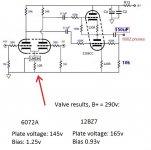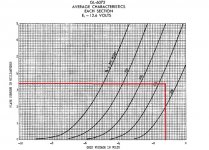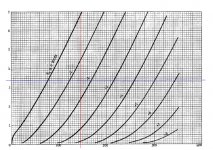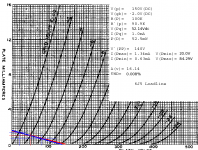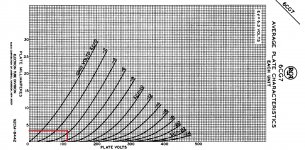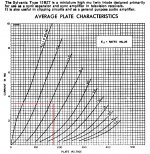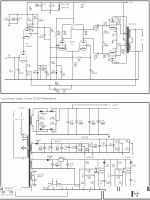I'm in the process of selecting a 9-pin double triode for a differential gain stage (circuit attached) and with a constant current source of 3.4mA per triode have what appear to be decent results for the 12BZ7 and 6072A. Is the graph I've plotted for the 6072A correct, and if so, how do we ascertain whether the linearity is decent?
Attachments
Those loadlines are incorrect. A CCS in the tail of an LTP doesn't make the plate current a constant. All it does is improve AC balance since, if one half sees its plate current increase by 2.0mA, the other side must decrease by 2.0mA since the combined cathode currents are held constant. With a passive tail load, you have AC imbalance since one side sees:
Vgk= Vi - Vtail
The other side sees:
Vgk= -Vtail
The error is proportional to: 1/(gm X Rtail)
The active tail load represents a very large Rtail that improves AC balance.
Just draw the loadline as for doing a single stage with a 25K slope on the plate characteristic and pick off the Q-point, the output swing, and voltage gain. Remember: when using an LTP for phase splitting, the voltage gain per phase is half of that for a single ended stage.
As for distortion, do the estimates as for a single stage, and remember that even harmonics null, leaving just the odd order harmonics. Although you do prefer low distortion since the nonlinearities that make for harmonic distortion also make for IMD.
Vgk= Vi - Vtail
The other side sees:
Vgk= -Vtail
The error is proportional to: 1/(gm X Rtail)
The active tail load represents a very large Rtail that improves AC balance.
Just draw the loadline as for doing a single stage with a 25K slope on the plate characteristic and pick off the Q-point, the output swing, and voltage gain. Remember: when using an LTP for phase splitting, the voltage gain per phase is half of that for a single ended stage.
As for distortion, do the estimates as for a single stage, and remember that even harmonics null, leaving just the odd order harmonics. Although you do prefer low distortion since the nonlinearities that make for harmonic distortion also make for IMD.
I see, excellent point in relation to the CCS holding the combined cathode currents constant.
Perhaps it is better to re-define the aims, the voltage gain itself is not important as my power amplifier has a passive attenuator attached, as such we might look for other lower mu double triodes with better linearity given the B+ there is to play with?
What about something like a 6BQ7?
Perhaps it is better to re-define the aims, the voltage gain itself is not important as my power amplifier has a passive attenuator attached, as such we might look for other lower mu double triodes with better linearity given the B+ there is to play with?
What about something like a 6BQ7?
I see, excellent point in relation to the CCS holding the combined cathode currents constant.
Perhaps it is better to re-define the aims, the voltage gain itself is not important as my power amplifier has a passive attenuator attached, as such we might look for other lower mu double triodes with better linearity given the B+ there is to play with?
What about something like a 6BQ7?
The only time I used the 6BQ7 was to make a cascoded LTP, and it works great for that. If not cascoding, then you have a VT that makes a questionable audio gain stage. In the spec sheet, there is no mention of audio use at all, and there is something squirrelly about that plate characteristic (undocumented variable-u characteristic?) Good loadlines can be found, but it takes some work, and you'll need to keep that VPK up without busting the PD spec.
I can't personally vouch for how the 6BQ7 will perform as a conventional, triode LTP, but George has used them for that purpose.
If gain isn't important, then the 6FQ7 would be a better choice, as this type is pretty much like the 6SN7 in the nine pin mini format.
If you need the type of gain a 6BQ7 can make, you could use 6AU6s as pseudotriodes, as these have very similar u-Factors, and the 6AU6 makes for a very good triode.
The only time I used the 6BQ7 was to make a cascoded LTP, and it works great for that. If not cascoding, then you have a VT that makes a questionable audio gain stage. In the spec sheet, there is no mention of audio use at all.....
If gain isn't important, then the 6FQ7 would be a better choice, as this type is pretty much like the 6SN7 in the nine pin mini format.
Good points once again.
Initially I opted for the 6072/12AY7 as it has decent gain and a very good reputation for audio use (which is also mentioned in its datasheet), plus - and here's the clincher - the LM334 constant current source peaks out at 10mA, which means 5mA per triode. 5mA and a B+ of 290v (the resulting plate voltage is only 100v when I tested with a 6FQ7) isn't anywhere near enough to get good linearity for the 6FQ7/6CG7.
So I dropped the CCS down to 7mA (3.5mA per triode) and experimented with lower current and thus higher gain but the 6072A looks to be in a safe and decent operating point with 145v on the plates, and 3.5mA current.
Ignoring the mu at this point, I guess the key question is, what 9-pin tube works best (= is most linear) at sub-5mA constant current source with a B+ of 300v?
Last edited:
Good points once again.
Initially I opted for the 6072/12AY7 as it has decent gain and a very good reputation for audio use (which is also mentioned in its datasheet), plus - and here's the clincher - the LM334 constant current source peaks out at 10mA, which means 5mA per triode. 5mA and a B+ of 290v (the resulting plate voltage is only 100v when I tested with a 6FQ7) isn't anywhere near enough to get good linearity for the 6FQ7/6CG7.
In the first place, I wouldn't use that "LM" thingie. It's better to make your CCSs from discrete BJTs and cascode them. That's how I do it. That way, there are no current limitations imposed, and the discrete solution simply works better. You don't need such heavy plate currents with the 6SN7-oids for good linearity. It's some of that audiophool folk "wisdom" that doesn't pan out in the real world. See the attached loadline. This is for the 6J5, an octal singleton that's essentially half of a 6SN7. The linearity is still excellent even when using it as a current trickler. What determines the linearity of triodes is keeping the loading as light as possible. The only reason to pump up the plate current is if you need a heavier load to improve wideband operation (as in a color TV matrix amp).
Ignoring the mu at this point, I guess the key question is, what 9-pin tube works best (= is most linear) at sub-5mA constant current source with a B+ of 300v?
Answer stays the same: 6FQ7/6CG7 (trioded 6AU6 if you really do need something with a u-Factor ~= 30). Not suggesting you set the plate current as low as 1.0mA, but 3.5mA should be sufficient for the application, especially if you don't need to swing a high voltage output, and it doesn't look like you need that here.
Attachments
Last edited:
I got the dB meter out last night and tested a series of tubes with in the gain stage to ascertain what the actual gain is when we have a plate current of 3.5mA and 290v B+:
This is for a 315Hz test signal - certainly interesting to see that there's only 11dB of difference across the whole range of tubes. Also strange that the 12AT7 has the same gain as the 5751/12AX7.
- 12BZ7 - 66.7dB
- 12AX7 - 64.8mA
- 12AT7 - 64.5dB
- 5751 - 64.8dB
- E180CC - 62.7dB
- 6N23P - 62.4dB
- 6072A - 61.2dB
- 6CG7 - 56.7dB
- 12BH7 - 55.3dB
This is for a 315Hz test signal - certainly interesting to see that there's only 11dB of difference across the whole range of tubes. Also strange that the 12AT7 has the same gain as the 5751/12AX7.
If you plug a 12AT7 and 12AX7 into the same circuit then at least one of them will be running at the wrong operating point and the wrong anode load so giving less than its best.Also strange that the 12AT7 has the same gain as the 5751/12AX7.
If you plug a 12AT7 and 12AX7 into the same circuit then at least one of them will be running at the wrong operating point and the wrong anode load so giving less than its best.
Indeed - but in terms of 'best', doesn't that depend on what one is looking for?
Isn't it also the case that where the gain/mu isn't close to the technical/datasheet gain then it may still be very linear, but not optimised for gain? Eg here's the 6072A curve (145v, 3.4mA), and the 12BZ7 curve (165v, 3.4mA), for a B+ of 290v. They both appear to be quite satisfactory in terms of linearity, although the mu of the 12BZ7 is well below it's potential.
If we set the mu aside and look at the B+ available with a plate resistor of 24k as per the schematic, it appears arguable that the 6072A is in fact more linear than a 6CG7 in this circuit.
Attachments
To "see" the linearity, wouldn't it be easier to look at the transfer characterisitc curves instead of the plate characterisitc curves? Here is the 12AX7 for example:
An externally hosted image should be here but it was not working when we last tested it.
This is what i go by, too. The straighter the Eb line, the mor linear. Easier to visualize than the plate characteristics, in which case we're looking for constant spacing of Ec lines along the loadline- more difficult to visualize. Transfer chars also make it easy to see just how much Ib is needed for good linearity. In the 12AX7 example above, things seems pretty linear above Ib=0.75 mA, more or less. Nice to find a tube that has such nice, straight lines all the way down into very small values of Ib and maintain good linearity across a useful range of Ec.
Excuse the slight off-topic, but is it an awful idea to use a 6N23P / e88cc as a phase splitter (to drive a pair of EL84's)? With ~280V HT and optimised values for this application.
is it an awful idea to use a 6N23P / e88cc as a phase splitter (to drive a pair of EL84's)? With ~280V HT and optimised values for this application.
According to Morgan Jones, that is the best tube to use in that application....I've never tried (happily using a 6SL7), but it would work very well.
I meant as a cathode coupled splitter... I have been playing around with that these days, seems the gain is not enough, and a CSS tail is mandatory....
I can't personally vouch for how the 6BQ7 will perform as a conventional, triode LTP, but George has used them for that purpose.
from my reading various posts here, it seems that a differential circuit
is more forgiving of triode linearity or lack of it....
the Radford circuit comes to mind, the LTP in that amp
consisted of a pentode and a triode.....
Attachments
- Status
- Not open for further replies.
- Home
- Amplifiers
- Tubes / Valves
- Determining linearity - differential gain stage
